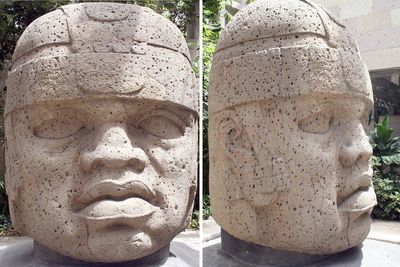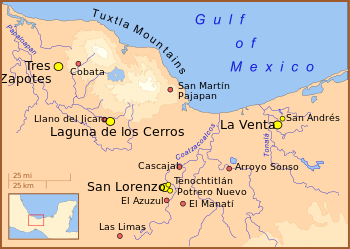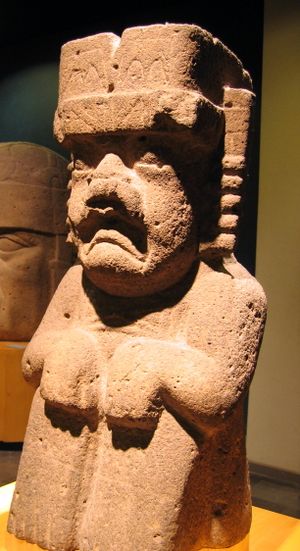سان لورنزو تنوتشتيتلان

سان لورنزو تنوتشتيتلان San Lorenzo Tenochtitlán أو سان لورنزو هو الاسم الجماعي لثلاث مواقع أثرية مرتبطة ببعضها البعض—سان لورنزو، تنوتشتتلان، و پوتريرو نويڤو— تقع في الجزء الجنوبي الشرقي من ولاية ڤيراكروز المكسيكية. فكان مع لا ڤنتا و تريس زاپوتس، أحد أهم ثلاث مدن رئيسية للأولمك، والمركز الرئيسي لثقافة الأولمك من 1200 ق.م. إلى 900 ق.م. San Lorenzo Tenochtitlán is best known today for the colossal stone heads unearthed there, the greatest of which weigh 28 metric ton (28 long ton; 31 short ton) or more and are 3 متر (9.8 ft) high.[1]
The site should not be confused with Tenochtitlan, the Aztec site in Mexico City. Administrative names were translated into Aztec/Nahuatl and spread alongside Catholic names during the European conquest, replacing any original locality names, the knowledge of which has often been lost.
الوصف
The earliest evidence for Olmec culture is found at nearby El Manatí, a sacrificial bog with artifacts dating to 1600 BCE or earlier. Sedentary agriculturalists had lived in the area for centuries before San Lorenzo developed into a regional center.[2]
التاريخ الأثري

سقوط سان لورنزو
The cause of San Lorenzo's demise and later replacement with La Venta is unknown, although it most certainly occurred in the 10th century BCE. Coe and Diehl originally suggested internal revolt or external conquest, but Diehl has since changed his mind. He now believes that the monuments were frequently recarved and reused before the collapse and the "mutilation" was simply the middle of that process. Warfare, environmental changes, economic decline, and the emergence of rival centers have all been suggested as possible causes for the decline, although multiple causes were likely. Evidence shows that the rivers of the region did change course at the time; that may have initiated or exacerbated other problems at the site of San Lorenzo.[3]
الهامش
انظر أيضاً
- El Azuzul, a small Olmec site just southeast of San Lorenzo Tenochtitlán and perhaps part of the complex.
- Tres Zapotes, a major Olmec and post-Olmec site roughly 100 ميل (160 km) northwest of the San Lorenzo complex.
المراجع
- Beck, Roger B.; Linda Black; Larry S. Krieger; Phillip C. Naylor; Dahia Ibo Shabaka (1999). World History: Patterns of Interaction. Evanston, IL: McDougal Littell. ISBN 0-395-87274-X.
- Clark, John E. (2000) "Gulf Lowlands: South Region", in Archaeology of Ancient Mexico and Central America: an Encyclopedia, ed. Evans, Susan; Routledge.
- Coe, Michael D. (1967) "San Lorenzo and the Olmec Civilization", in Dumbarton Oaks Conference on the Olmec, Dumbarton Oaks, Washington, D.C.
- Cyphers, Ann (1999) "From Stone to Symbols: Olmec Art in Social Context at San Lorenzo Tenochtitlán", in Social Patterns in Pre-Classic Mesoamerica, Dumbarton Oaks, Washington, D.C., pp. 155 – 181.
- Diehl, Richard (2004). The Olmecs: America's First Civilization. London: Thames & Hudson Ltd. ISBN 0-500-28503-9.
- Flannery, Kent V. (1982) "Archaeology in the Land of the Olmec: The Archaeology of San Lorenzo Tenochtitlan Volume 1. Michael D. Coe and Richard A. Diehl.: In the Land of the Olmec: The People of the River, Volume 2. Michael D. Coe and Richard A. Diehl" in "American Anthropologist"; June 1982, Vol. 84 Issue 2, pages 442–447.
- Lawler, Andrew (2007) "Beyond the Family Feud", in Archaeology; Mar/Apr 2007, Vol. 60 Issue 2, pp. 20–25.
- The National Institute of Anthropology and History (INAH) San Lorenzo website
- Pool, Christopher A. (2007). Olmec Archaeology and Early Mesoamerica. Cambridge: Cambridge University Press. ISBN 978-0-521-78882-3.
- Symonds, Stacey (2000). The Ancient Landscape at San Lorenzo Tenochtitlán, Veracruz, Mexico: Settlement and Nature. London: Yale University Press.
- Wendt, Carl J. (2005) "Using refuse disposal patterns to infer Olmec site structure in the San Lorenzo region, Veracruz, Mexico." in "Latin American antiquity : a journal of the Society for American Archaeology" Vol. 16, no. 4 (2005), p. 449–466 ill.
- The Olmec: Mother Culture of Mesoamerica by Roman Pina Chan
